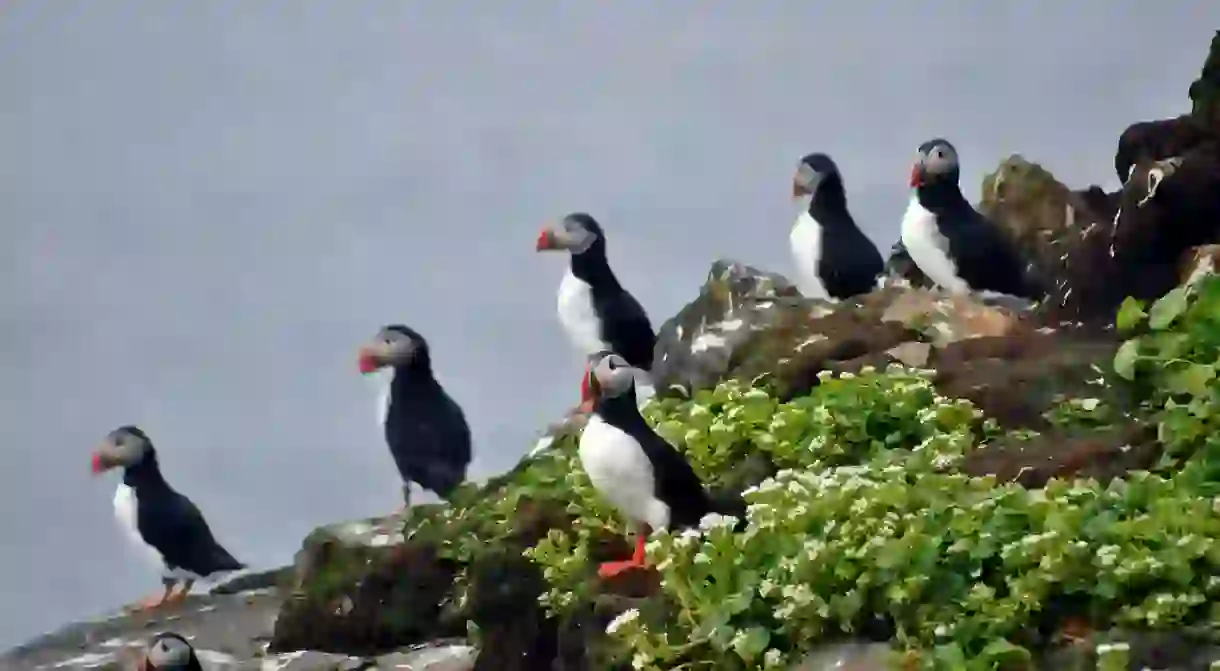The Most Epic Spots in Iceland to Spot Puffins

This small seabird, sometimes known as ‘the clown of the sea’ because of its multicolored beak, has almost become a symbol of Iceland itself, and for good reason, because it has the largest puffin population in the world. Puffin colonies in their natural habitat are dotted all over the country, where you can visit and observe. Here are some of the most scenic places to spot them.
Ísafjarðardjúp
This is the fjord on which the largest city in the Westfjörds, Ísafjörður, lies. Ísafjarðardjúp is actually a fjord system, with eight unique fjords. As you progress from the southeast of Ísafjarðardjúp, each fjord has progressively steeper and taller mountains, until you reach Skutulsfjörður in the northwest. The fjord includes Vigur island, a huge puffin nesting colony, and other smaller inlets that are also great for birdwatching.

Flatey Island
This tiny, remote and sparsely inhabited island lies between the Snæfelsness peninsula and the Westfjörds in Northwest Iceland. It is the largest island of about 40 islands located in Breiðafjörður bay, and is very flat – that’s how it gets its name. As there are no cars on the island, and all of it is very walkable, it makes a great birdwatching place with its many seasonal bird colonies of puffin as well as Arctic tern. Stay at the lovely Hotel Flatey, the only hotel on the island.

Vestmannaeyjar
Vestmannaeyjar, or the Westman Islands, are a cluster of 15 islands to the south of Iceland. It’s easy to get here by taking a ferry from the south coast. Here, the puffins arrive in summer to mate and form the world’s biggest puffin colony, with over 1.1 million puffins laying their eggs there. You can find boat tours to take you around the coastline of the island where you can observe the birds. Walk among the beautiful green cliffs and, lying on your belly, observe the puffin nests in the rocks below.

Lundey
Visited as part of the whale-watching tours from the small northern fishing village of Húsavík, Lundey Island offers a great opportunity to see puffins. The island is even named after the Icelandic name for puffins, lundi. The small island is uninhabited by humans, which gives the rich birdlife there peace and tranquillity. It is a good chance to observe how the puffins make their burrows, which is done by a process of digging with their bills and feet and shovelling the dirt out behind them. Their preferred site is between rocks and steep cliffs, making this rocky island a perfect place.

Látrabjarg
The steep cliffs of Látrabjarg in the Westfjörds are a great puffin observation point. This remote area offers great opportunities for photography, as the birds are quite tame. However, a few accidents have occurred involving photographers on the steep cliffs, so be careful to watch your footing; the best approach is usually to lie on your belly or sit in the grass, to avoid any mishaps close to these very steep and majestic cliffs. The small birds, which are only about 18 centimetres (7 inches) tall, can be hard to photograph up close.

Vigur Island
In the Westfjörds, you can take a sailboat tour to the island of Vigur. The island has just one human family living there permanently. The island is also the home of about 100,000 puffin pairs that return year after year to lay their eggs. These monogamous birds even come back to the same burrow each year.

Dýrholaey
The picturesque stone archway of Dýrholaey, close to the small village of Vík on the south coast, is one of the most popular tourist destinations in Iceland. Dýrholaey is surrounded by the black sand beaches of Reynisfjara and other stone monuments out at sea, called Reynisdrangur. The rocks around Dýrholaey are bustling with puffin activity, as the structure’s cliffs make the perfect place for burrowing.

Papey Island
The tiny island of Papey off the east coast of Iceland is rumoured to have been settled by Irish monks long before mainland Iceland, hence the island’s name. Interestingly, the puffin, with its distinctive upright stance, shares some visual similarities with the monks. Furthermore, the puffin’s scientific name is fratercula arctica, fratercula, meaning ‘little priest’.

Tjörnes
The Tjörnes peninsula is a geological wonder in north Iceland. Its cliffs are made up of layers, the most ancient ones being about 2 million years old. The peninsula is closest to the fishing village of Húsavík and is home to a large puffin colony.

Grímsey
Grímsey Island is the northernmost part of Iceland, and is crossed by the Arctic Circle. The Arctic puffin, accordingly, makes many nests here in the high cliffs. The ferry connects the mainland with Húsavík three times a week.














